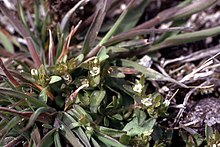
Plagiobothrys is a genus of flowering plants known commonly as popcorn flowers. These are small herbaceous plants which bear tiny white or yellow flowers. Their fruits are nutlets. Although these plants are found predominantly in North America and South America, five species are known from Australia. Of the approximately 65 species described, more than 15 are endemic to California.
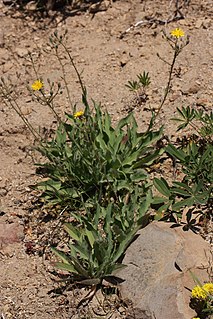
Pilosella scouleri is a North American species of flowering plant in the dandelion tribe within the sunflower family. It is known as Scouler's woollyweed. It is native to western North America, from British Columbia and Alberta in Canada, south to northern California and Utah in the United States.

Plagiobothrys arizonicus is a species of flowering plant in the borage family known by the common name Arizona popcornflower.

Plagiobothrys canescens is a species of flowering plant in the borage family known by the common name valley popcornflower. It is endemic to California, where it is a common wildflower in valley, foothill, desert, coastline, and canyon habitat in the central and southern regions of the state.

Plagiobothrys collinus is a species of flowering plant in the borage family known by the common name Cooper's popcornflower.
Plagiobothrys distantiflorus is a species of flowering plant in the borage family known by the common name California popcornflower. It is endemic to California, where it is known only from the northern and central Sierra Nevada foothills.
Plagiobothrys fulvus is a species of flowering plant in the borage family known by the common names field popcornflower or fulvous popcornflower. It is native to California and Oregon in the United States, as well as Chile.
Plagiobothrys greenei is a species of flowering plant in the borage family known by the common name Greene's popcornflower. It is native to Oregon and northern California, where it grows in moist woodland and grassland habitat. It is an annual herb with a spreading or erect stem growing 10 to 40 centimeters long. The leaves along the stem are 1 to 5 centimeters long and the herbage is coated in rough hairs. The inflorescence is a series of tiny flowers with white five-lobed corollas no more than 3 millimeters wide. The fruit is a minute nutlet with a surface covered in long prickles.
Plagiobothrys hispidus is a species of flowering plant in the borage family known by the common names Cascade popcornflower or bristly popcornflower. It is native to the mountains and plateaus around the intersection of Oregon, northeastern California, and northwestern Nevada, where it grows in dry, sandy habitat. It is an annual herb growing erect to a maximum height around 20 centimeters. It is very hairy, with rough and woolly hairs. The pointed leaves are up to 4 centimeters long. The inflorescence is a short, coiling series of tiny white flowers each only about a millimeter wide.
Plagiobothrys humistratus is a species of flowering plant in the borage family known by the common names dwarf popcornflower or low popcornflower. It is endemic to the Central Valley of California, where it grows in grassland habitats, including vernal pools and other wetland areas.
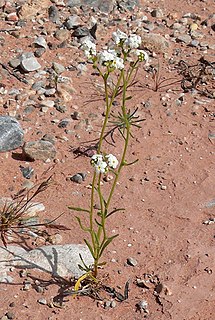
Plagiobothrys jonesii is a species of flowering plant in the borage family known by the common name Mojave popcornflower. It is native to the southwestern United States and northern Mexico, where it grows in desert mountains and flats in scrub and woodland habitat.
Plagiobothrys kingii is a species of flowering plant in the borage family known by the common name Great Basin popcornflower. It is native to the Great Basin and Mojave Desert of the United States, where it grows in desert and plateau scrub habitat, among saltbush and on rocky slopes and flats.
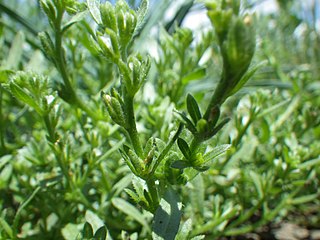
Plagiobothrys leptocladus is a species of flowering plant in the borage family known by the common names finebranched popcornflower and alkali plagiobothrys. It is native to western North America from Alaska to the Dakotas to northern Mexico, where it can be found in varied types of wet habitat, including inundated alkali flats and vernal pools.

Plagiobothrys nothofulvus is a species of flowering plant in the family Boraginaceae known by the common names rusty popcornflower and foothill snowdrops. It is native to western North America from Washington, and California, to northern Mexico. It is a spring wildflower in grassy meadows, woodlands, coastal sage scrub, and wetland-riparian habitats.
Plagiobothrys parishii, known by the common name Parish's popcornflower, is an uncommon species of flowering plant in the borage family.
Plagiobothrys shastensis is an uncommon species of flowering plant in the borage family known by the common name Shasta popcornflower. It is native to southern Oregon and northern California, where it grows in grassland, woodland, and other types of habitat. It is an annual herb growing erect to about 30 centimeters in maximum height. It is coated in hairs. The leaves are located in a basal rosette with a few arranged alternately along the stem. The inflorescence is a straight branch holding paired flowers, rarely coiling at the tip as many other Plagiobothrys do. Each tiny white flower has a five-lobed corolla no more than 3 millimeters wide. The fruit is a cross-shaped nutlet 2 or 3 millimeters wide divided in half by a rough scar.
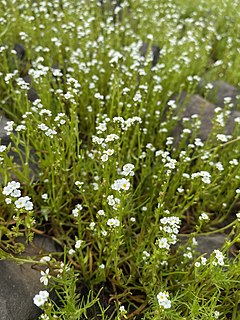
Plagiobothrys stipitatus is a species of flowering plant in the borage family known by the common name stalked popcornflower and stipitate forget-me-not. It is native to Oregon and most of California, where it grows in vernal pools and similar wet habitat types. It is an annual herb producing a narrow, hollow, erect stem up to half a meter tall. It is coated in rough hairs. The pointed, hairy leaves along the stem are up to 11 centimeters long. The inflorescence is a series of five-lobed white flowers 2 millimeters to over one centimeter wide. The fruit is a narrow, ribbed nutlet.
Plagiobothrys tenellus is a species of flowering plant in the borage family known by the common names Pacific popcornflower and slender popcornflower. It is native to western North America from British Columbia to Mexico, where it is a common member of the flora in several types of habitat.
Plagiobothrys uncinatus is a species of flowering plant in the borage family known by the common names Salinas Valley popcornflower and hooked popcornflower. It is endemic to the Central Coast Ranges of California, where it is known mainly from the Santa Lucia Mountains and Gabilan Range in Monterey County.
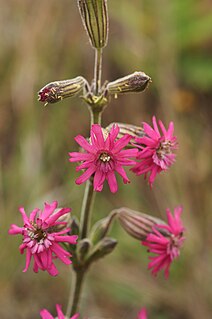
Silene scouleri is a species of flowering plant in the family Caryophyllaceae known by the common names simple campion and Scouler's catchfly.
